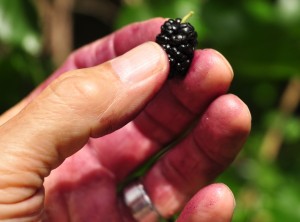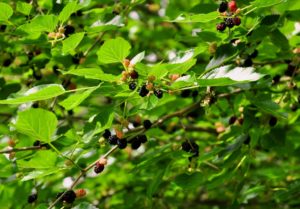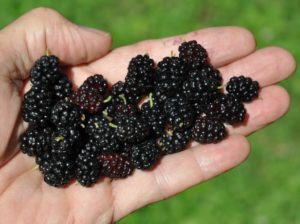Photography courtesy of Lowell Washburn, all rights reserved.
Comedian Rodney Dangerfield was best known for his trademark phrase, “I don’t get no respect.”
I suspect that, if the lowly mulberry bush had feelings, it could relate. Although few fruit bearing plants annually produce a more abundant crop, most people ignore or even scorn this tasty and nutritious wild edible. Although there are many reasons for this; ignorance leads the pack. Most people just don’t know how good a juicy, fully ripened, black mulberry can taste. Mulberries also pack a punch. Mulberries contain more than 20 vitamins and minerals. A level cup contains 60 calories; 11 g of sugar and 14 carbs. By comparison, the same cup of wild raspberries has 63 calories; 5 g of sugar and 15 carbs. Instead of producing a single annual crop, mulberries continue to produce for weeks. This year’s crop has already been ripening and falling to the ground for three weeks now and there are tons more on the way.
There are some legitimate gripes. Most people understandably object to is the way mulberries tend to stain everything they touch. There’s no way to avoid this, I guess — unless maybe you wear rubber gloves while picking. Speaking of “mulberry dye”, some of you will remember Back in the Day when housewives — Yea, I used that word — used to hang laundry on backyard clothes lines. Back then, every homemaker could tell you — almost to the hour — when the local robin population began feeding on ripe mulberries. Freshly laundered white sheets seemed to be the robins’ favorite target.
In addition to the dark stains, most people also object to the berry’s, virtually impossible to remove green stem. There’s a simple solution to this one. Simply ignore the stems and eat the fruit — stems and all. Try a handful. You won’t even know the soft stems are there.

In addition to being good for people, mulberries are also a favorite with wildlife. Birds love them and mulberry trees are an absolute deer magnet. The best news is that there’s always plenty for everyone.





 Susan Judkins Josten
Susan Judkins Josten Rudi Roeslein
Rudi Roeslein Elyssa McFarland
Elyssa McFarland Mark Langgin
Mark Langgin Adam Janke
Adam Janke Joe Henry
Joe Henry Sue Wilkinson
Sue Wilkinson Tom Cope
Tom Cope Kristin Ashenbrenner
Kristin Ashenbrenner Joe Wilkinson
Joe Wilkinson Dr. Tammy Mildenstein
Dr. Tammy Mildenstein Sean McMahon
Sean McMahon